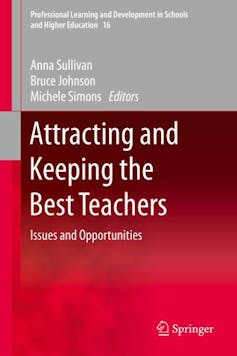Fewer casual positions and less out-of-hours work could help retain early career teachers
- Written by Michele Simons, Dean of Education, Western Sydney University
Australia, like many other countries, is grappling with the problem of how to keep good teachers in schools, especially those who are early in their careers.
Accurate data on the attrition are not available, but it’s estimated up to 50% of teachers leave the profession within five years of graduating.
This is a serious issue for a number of reasons we outline in our new book, Attracting and Keeping the Best Teachers, out this month.
Read more: Three charts on teachers' pay in Australia: it starts out OK, but goes downhill pretty quickly
A waste of time, effort and resources
Educating teachers who leave the profession early is a wasteful and inefficient use of public funds. Educational funding is diverted from school resources and facilities to recruitment and replacement.
Schools lose the expertise of new, high-achieving graduates and are destabilised and disrupted by any high staff turnover. Student learning can be compromised by this churn. It takes time for students to build relationships and adjust to learning with new teachers who are not guaranteed to be as expert as the ones they are replacing.
As for the early career teachers, the costs can be high in terms of the social, emotional, economic and (potentially) geographic dislocation that can occur when a graduate’s personal and career aspirations are damaged due to their decision to leave the teaching profession.
This issue is becoming more serious in Australia because we are experiencing early signs of a teacher supply problem. For example, fewer people are being attracted to a career in teaching.
There are growing shortages of teachers in specific subject areas such as mathematics and science.
There is also an increasing difficulty in recruiting teachers to schools in rural and remote regions, or in communities facing significant social and economic challenges.
If we don’t find ways to keep good teachers, it’s likely the system will have to cope with teacher shortages by increasing class sizes, recruiting less qualified teachers and allocating teachers to teach outside of their field of expertise.
Clearly, these ways of addressing a lack of teachers undermine the quality of education.
So we need to find ways to prevent good teachers from leaving the profession for the wrong reasons.
How to keep early career teachers
Our recent compilation of research from a group of international scholars offers new ways to retain early career teachers. Two related workforce development strategies stand out from this work.
 Available as an ebook and in hardcover.
Springer
Available as an ebook and in hardcover.
Springer
It’s well known many early career teachers begin their working lives in insecure, casual work. This entrance into teaching often comes with low wages and few opportunities for the mentoring and other support that more securely employed teachers might experience.
In one contribution in our book, University of Canberra education researcher Barbara Preston’s argument is simple – rather than relying on new graduates to fill the (increasing) demand for casual work, workforce strategies should instead look to:
develop more robust ways to model the supply and demand for teachers
reduce the overall number of casual positions needed to staff schools by appointing more permanent teachers
professionalise relief and casual work by looking to create forms of permanent casual employment that are attractive for more senior teachers to take up (for example, as part of a transition to retirement)
regulate the forms of employment that can be undertaken by early career teachers.
Our research confirms that principals also play a crucial role in shaping what work is like for early career teachers.
For example, principals can think about the spaces allocated to new teachers in staff rooms. It’s important to have spaces that are inviting, make teachers feel welcome and where they can talk or engage in the private work they need to do for classes.
Staff rooms are also places where a lot of professional knowledge is exchanged and where new teachers can access the “know how” of more experienced teachers. These are important places where early career teachers can relax, take time out and refresh themselves for the next part of their busy day.
Read more: Teachers who feel appreciated are less likely to leave the profession
Principals can also restrict the extra work new teachers are asked to do out of the classroom, and position early career teachers as assets to their staff and the wider school community.
All these actions matter. They affect the relationships early career teachers build with their employer and subsequently have an impact on their view of the profession as a sustainable career choice.
We believe these human resource strategies will support early career teacher retention and reduce the attrition rate.
Authors: Michele Simons, Dean of Education, Western Sydney University





